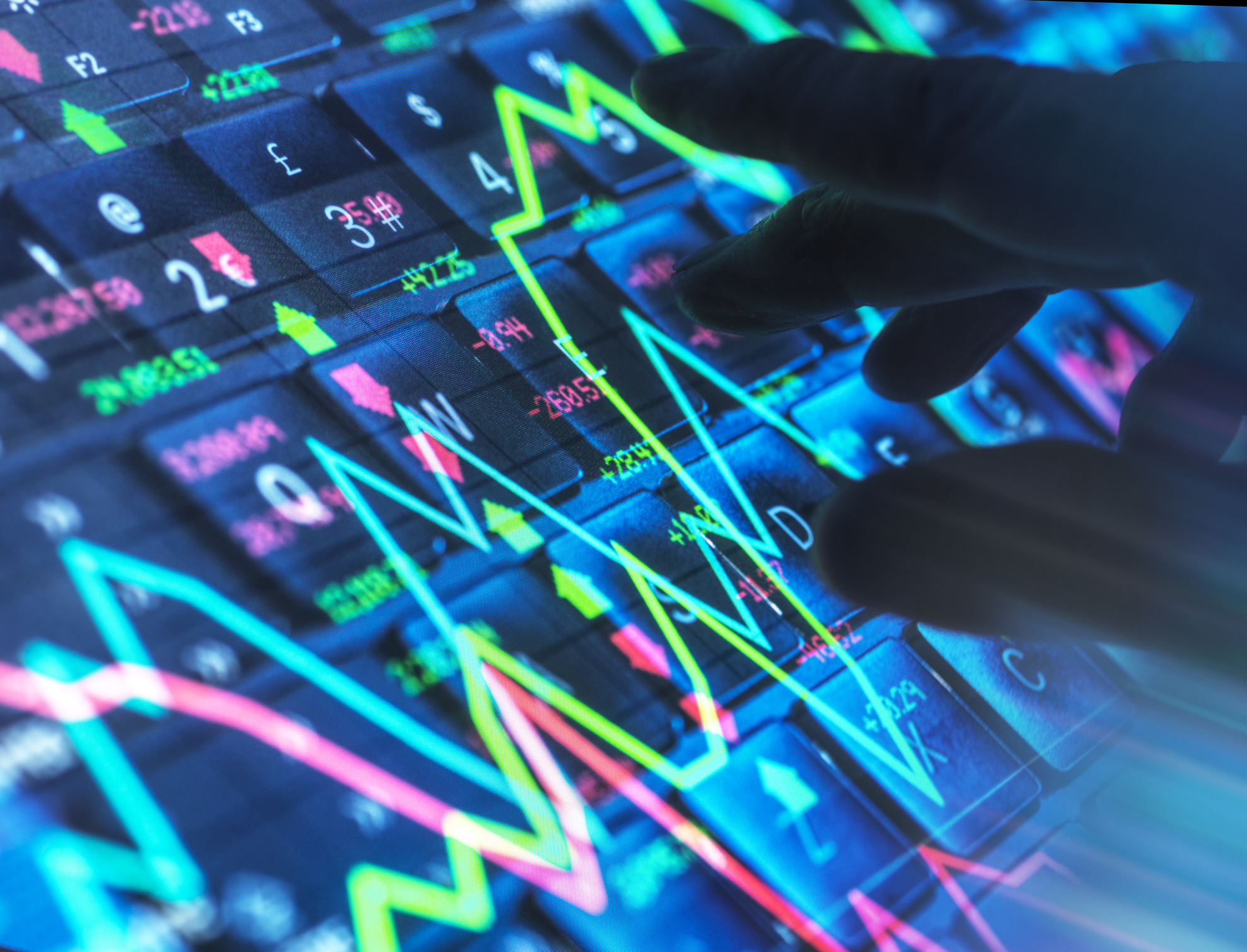Midyear Investing Outlook: Where to Invest Now
Much hinges on whether the Fed can guide the economy to a soft landing.


Like any good serial, the financial markets have set up a doozy of a cliff-hanger as investors look toward the second half of 2022. Will inflation moderate or continue to blaze, consuming more of our spending power and investment returns in the process? Will the Federal Reserve manage the high-wire act of raising interest rates just the right amount at just the right pace to dampen inflation without tipping the economy into recession? That’s a balancing act it has pulled off in only three of the past 11 extended rate-hiking cycles, according to Deutsche Bank—a dismal success rate of less than one-third. Will the downward trend in financial markets spiral into a widespread bear market in stocks and more carnage in bonds? Or is a snapback in order if the bad news—including about the invasion of Ukraine and the course of COVID—starts to abate?
We wish we could tell you how the story ends. What we can say is that gains will likely come stock by stock, rather than by monolithic market moves, and they will be accompanied by a lot of volatility—in both directions—between now and year-end. Investors should remain agile and alert to opportunities, with enough cash on hand to take advantage of them—as much as 5% to 8% of your portfolio or even more, says Jared Woodard, head of the research investment committee at BofA Securities. “We think that in the second half, risks and rewards are pretty balanced,” says Woodard. “In other words, there are as many ways to see an upside to stocks as to see downsides.” A focus on firms that are resilient and cash rich might be a better bet than going all-in on any particular style, sector or market value.
In our January outlook, we called for returns in the high-single-digit percentages for the year, with a target for the S&P 500 index of just above 5,000. That might be optimistic at this point, given the rout that has pulled the S&P 500 down 14% from its record high on January 3 through its close at 4,123 on May 6 (the date for prices and returns in this article, unless otherwise noted). Down 24% from its high in November, the tech- and growth-stock-heavy Nasdaq index is in bear market territory (defined as a loss of 20% or more). In a mercurial market with little conviction, the range of possible outcomes for the remainder of the year is wide. What happens will depend on a host of factors, including how corporate profits hold up and how much investors are willing to pay for those earnings.
From just $107.88 $24.99 for Kiplinger Personal Finance
Become a smarter, better informed investor. Subscribe from just $107.88 $24.99, plus get up to 4 Special Issues

Sign up for Kiplinger’s Free Newsletters
Profit and prosper with the best of expert advice on investing, taxes, retirement, personal finance and more - straight to your e-mail.
Profit and prosper with the best of expert advice - straight to your e-mail.
Market strategist Ed Yardeni at Yardeni Research is calling for the S&P 500 to close the year somewhere between 4,200 (up 1.9% from its May 6 close) and 5,000 (up 21%). That’s based on his earnings forecast for companies in the S&P 500, to which he applies a price-earnings multiple ranging from 16 to 19 (the S&P 500 recently traded at 17.6 times earnings). “The wide range reflects our assessment of uncertainty,” says Yardeni. His approach seems reasonable. Forecasts will no doubt firm up as the year plays out. But for now, we’re leery of inflexible market views and are keeping close tabs on the following developments.
The Federal Reserve Wrestles with Inflation
By March, inflation spiked to an 8.5% annual rate, the highest since 1981, when the median cost of a new home was $68,400 and gas was $1.37 a gallon. In April, the rate slipped to 8.3%. The surge in consumer prices is the result of strong demand, bolstered by fiscal stimulus, colliding with pandemic-snarled supply chains and soaring energy prices in the wake of Russia’s invasion of Ukraine. But signs of a peak are appearing, including a recent dip in sky-high used-car prices. Kiplinger believes inflation will end the year at 6.3% then drift lower in 2023.
A newly hawkish Federal Reserve is fighting inflation by raising rates to cool the demand side of the economy. It raised the target range for its benchmark Federal Funds rate by a quarter point in March, then doubled down in May with a half-point hike. Fed watchers expect two more half-point hikes this summer, followed by more quarter-point hikes later in the year. The Fed Funds rate could close out 2022 around 2.5%; the yield on 10-year Treasury bonds, dependent more on inflation expectations than on the Fed, will likely peak at 3.5% sometime this year but could dip by December. The good news is that stocks tend to do well in the first year of Fed rate hikes. Looking back some 65 years, Deutsche Bank found that 12 months following the first hike, the stock market was up 91% of the time, by an average of 7%.
The challenge is raising rates just enough to tap the brakes on the economy without choking off growth, and experts are divided on whether the Fed is behind the curve on inflation or confronting it too heavy-handedly. David Kelly, chief global strategist at J.P. Morgan Asset Management, believes the Fed should take a cue from the old Roberta Flack song and use a “killing it softly” approach. “The key is for the Fed to understand that inflation is moderating on its own. There’s no need to be too aggressive, and that’s the single most important thing that will help markets,” he says. (For more on Kelly’s view of the markets, see our interview, Buy Value Stocks, Says J.P. Morgan’s David Kelly.)
Is a Recession Coming? How About Stagflation?
Wall Street is always a battle of bulls and bears, but when it comes to the outlook for the economy, rarely have the sides been so evenly matched. “The lack of conviction in markets is apparent,” wrote credit analysts at BofA Securities in a recent note to clients. “On one hand we have strong corporate and household balance sheets, a booming labor market and no meaningful areas of economic over-extension. On the other we are facing raging inflation, geopolitical risk and a mixed bag of earnings.” Kiplinger sees the economy growing 2.5% in 2022, down from 5.7% in 2021. But there are plenty of takers on Wall Street for each of three possible economic scenarios: recession, stagflation or expansion.
Preliminary estimates show that U.S. gross domestic product declined at an annual rate of 1.4% in the first quarter, adjusted for inflation—putting us halfway to a recession already, given that they are often defined as two consecutive quarters of decline. The economy grew at a rate of 6.9% in 2021’s fourth quarter, by contrast.
The Fed’s track record of engineering a soft landing for the economy is little comfort, with eight of the 11 tightening cycles since 1958 ending in recession, per Deutsche Bank. The lead time from the onset of rate hikes to recession was long—typically just over two years—so any recession is still a ways off. But stock market peaks preceded those economic downturns by an average of five months.
Yardeni, for one, still believes we’ll avoid a recession—but the odds we’ll suffer one have increased, he says. “You have to be realistic. Now, instead of 15%, I think the odds are 30%. Maybe it’s time to raise the odds to 40%, but I’m not there yet.”
Instead, Yardeni sees a stagflationary scenario, in which the economy grows at a slow 2% alongside inflation that recedes from today’s sky-high levels but remains higher than we’ve been used to and persists for longer. Call it “stayflation,” he says. It’s worth noting that stocks in general are a time-tested hedge against inflation. Going back 96 years, large-company stocks have returned an annualized 10.5%, far outpacing inflation’s 2.9%.
Ryan Detrick, chief market strategist at LPL Financial, is upbeat. The economy is experiencing a mid-cycle slowdown, not the end of the expansion. It’s akin to what happened in 1994, he says. Back then, “the Fed hiked and the economy teetered but eventually continued to grow.” Similarly, despite one of the worst starts to the year ever, Detrick believes the bull market “is likely just catching its breath; it’s not about to end soon.
The Bull Case: Look at Fundamentals
With so much worry and uncertainty over the macroeconomic situation and geopolitical events, investors have lost sight of strong corporate fundamentals, the bulls say. Confidence levels are certainly down. Near the end of April, almost 60% of investors surveyed by the American Association of Individual Investors expected stocks to decline over the next six months. Bearish sentiment declined to 52.9% in early May, but the reading still marked the 23rd week out of the past 24 that pessimism remained above its historical average of 30.5%, and it was the 13th week out of the past 16 that bearish sentiment clocked in at an unusually high level, says AAII.
Despite a solid, if not perfect, first-quarter earnings season and an upward revision in the consensus of analysts’ earnings forecasts, P/Es for stocks overall have come down from just over 22 at the start of the year to 17.6 recently—implying that either analysts are too optimistic in their estimates or investors are too pessimistic in their valuations. “Corporate profits do well in times of higher inflation; companies tend to pass it on to customers much better than we think they can,” says Jonathan Golub, chief U.S. equity strategist at Credit Suisse. Profit margins are holding up well in economically sensitive sectors such as industrials, consumer nonessentials and raw materials, he notes.
Nonetheless, Golub recently cut his year-end target for the S&P 500 from 5200 to 4900, though he remains bullish. “Calibrating an exact return is less important than framing the question: Is now a good time to be in the stock market? The answer is ‘yes.’ Returns are going to be robust over the next 12 months even in light of risks.”
On the other side of the bet is strategist Mike Wilson at Morgan Stanley, who thinks the market is telegraphing that “the first quarter may be the last good quarter of earnings as higher costs and increased recession risks weigh on future growth.” He says the broad market has already commenced a bear market that will ultimately sink the S&P 500 to 3800 at a minimum (a 7.8% decline from its recent close) and possibly to 3460 (down 16%). “It has been a rough ride. It’s going to get rougher, but we’ll come out the other side,” he told viewers on financial network CNBC recently. “We’re closer to the end than to the beginning.”
Wild Cards: Ukraine and the Midterms
The war in Ukraine and the U.S. midterm elections will be important factors for the financial markets in 2022, factors over which central bankers have zero control. The former is far more a threat to international markets—particularly in Europe, which is more dependent on energy imports from Russia and more susceptible to the recessionary fallout from the war.
As for the U.S. midterms, they can be rough on investors, and this year is no exception. But this year’s election is unlikely to spring any surprises, says Philip Orlando, chief equity market strategist at financial firm Federated Hermes, and the market may like the outcome. He notes that since World War II, Democrats have lost an average of 38 seats in the House of Representatives—where they currently hold a majority of just 13 seats—in the first midterm election. A divided government will reintroduce some checks and balances on fiscal policy, he says, which financial markets will view as a positive. “We think the market is going to be happy with the election results,” says Orlando, who sees the election as a catalyst for a fourth-quarter rally that takes the S&P 500 back to 4800 and then continues into the new year.
Growth Stocks vs. Value Stocks, Again
Market upheaval is nerve-racking—but it’s also replete with opportunities. Keep a watch list of stocks and funds you’d like to pounce on when the price is right and maintain a rigorous rebalancing schedule in your portfolio. With so much uncertainty, the best course of action is to hope for the best and prepare for the worst. In other words, it has never been so important to stay diversified and aligned with your tolerance for risk.
In keeping with that philosophy, Credit Suisse has compiled two lists of stocks: Top 50 Beneficiaries of Economic Expansion and Top 50 Beneficiaries of Economic Recession. On the first list you’ll find specialty chemical company Albemarle (ALB, $242), cable and satellite provider DISH Network (DISH, $22), energy equipment and services firm Halliburton (HAL, $37), gaming company Penn National Gaming (PENN, $34) and Signature Bank (SBNY, $235).
On the second list is discount retailer Dollar General (DG, $234), packaged-food company General Mills (GIS, $71), utility NextEra Energy (NEE, $72), real estate investment trust Public Storage (PSA, $337), and health care tools and services firm Thermo Fisher Scientific (TMO, $547).
The perennial contest between growth-focused stocks and value-priced fare is likely to end in a draw in the second half of the year. “We see opportunities in both value and growth,” says Saira Malik, chief investment officer at financial firm Nuveen. “Growth stocks are looking more attractive and are well positioned as economies slow. And value could benefit from still-high inflation.” Selectivity is key with growth stocks—especially the mega-cap behemoths, many of which have already taken it on the chin. Malik still likes Amazon.com (AMZN, $2,295) and Microsoft (MSFT, $275). She considers both to be uniquely positioned for the long term and likes Microsoft’s 0.9% yield.
In the value camp, Malik recommends energy stocks—and she is not alone, with many of the strategists we spoke with bullish on the sector despite its recent meteoric rise. Energy stocks typically struggle in weaker economies, Malik concedes, “but I love the fundamentals of the industry,” she says. Supplies are tight and getting tighter because of the war in Ukraine, demand is increasing as global economies reopen, and energy firms are more disciplined producers these days, focused on returning cash to shareholders and not overbuilding. Big oil firms top the portfolio at Fidelity Select Energy (FSENX), with Exxon-Mobil, Chevron and ConocoPhillips representing one-third of assets. Investors who prefer an index approach can consider Energy Select Sector SPDR (XLE, $83), an exchange-traded fund also dominated by the big oil majors. You’ll find a more balanced portfolio in the Invesco S&P 500 Equal Weight Energy ETF (RYE, $73), with holdings such as Valero Energy and EOG Resources on equal footing with the giants.
Stocks of companies that produce and process raw materials have also been strong but still look attractive. Energy policy—no matter which way it tilts—will favor these stocks over the long term, says BofA’s Woodard. “Whether you care about resource independence or decarbonization, we can’t figure a world where either takes place without copious amounts of raw materials. Given how under-valued these resource companies are, they represent great opportunities.” One ETF worth exploring is SPDR S&P Metals and Mining (XME, $54).
Analysts at Goldman Sachs recommend shelving the growth-value debate to look for stocks with stable growth and low volatility. “In the current angst-ridden investing environment, we believe stability represents a more attractive attribute.” According to Goldman, stocks that fit the bill include advertising company Omnicom (OMC, $77), health care firm Johnson & Johnson (JNJ, $176) and payments giant Visa (V, $203). Goldman also recently raised its forecast for dividend growth for S&P 500 companies to 10% this year; the firm notes that dividend stocks trade at attractive valuations and typically outperform during periods of elevated inflation. Stocks in the Kiplinger Dividend 15 (the list of our favorite dividend stocks) that are also singled out by Goldman include AbbVie (ABBV, $153, yield 3.7%), Texas Instruments (TXN, $167, 2.8%) and Verizon Communications (VZ, $48, 5.3%). Dividend funds we recommend include T. Rowe Price Dividend Growth (PRDGX) and Vanguard Dividend Appreciation (VIG, $153).
Small-company stocks are compellingly inexpensive and could benefit as consumers shift their focus from goods to services—but they’ll suffer if the economy rolls over. If you’re willing to wade in now, consider Vanguard S&P Small-Cap 600 Index (VIOO, $182), an ETF that tracks the S&P SmallCap 600 index. The index requires constituents to be profitable, so compared with other small-cap benchmarks, it has a slight quality tilt.
Investing overseas has both fans and detractors at the moment as well, with Europe, especially, looking both cheap and risky. Fidelity International Growth (FIGFX), a member of the Kiplinger 25 (the list of our favorite no-load funds), has a 45% stake in developed Europe. Top holdings include ASML, Nestlé and Roche.
Health care stocks are trading at near-record discounts to the broad market, offering investors growth at a reasonable price and lending some defense to portfolios. They will also benefit from aging demographics and a likely post-pandemic pickup in health care spending, according to BofA Securities. Two funds we like are Fidelity Select Health Care (FSPHX) and Invesco S&P 500 Equal Weight Health Care (RYH, $280), members of the Kiplinger 25 and ETF 20, respectively.
Finally, take advantage of what promises to be a long-term theme of deglobalization with stocks that will do well as businesses seek to strengthen supply chains by either relocating operations closer to home or focusing on manufacturing efficiency rather than on inexpensive labor. Industrial firms that could benefit include Emerson Electric (EMR, $88), Fortive (FTV, $61), Jacobs Engineering (J, $138) and Parker Hannifin (PH, $272).
Profit and prosper with the best of Kiplinger's advice on investing, taxes, retirement, personal finance and much more. Delivered daily. Enter your email in the box and click Sign Me Up.

Anne Kates Smith brings Wall Street to Main Street, with decades of experience covering investments and personal finance for real people trying to navigate fast-changing markets, preserve financial security or plan for the future. She oversees the magazine's investing coverage, authors Kiplinger’s biannual stock-market outlooks and writes the "Your Mind and Your Money" column, a take on behavioral finance and how investors can get out of their own way. Smith began her journalism career as a writer and columnist for USA Today. Prior to joining Kiplinger, she was a senior editor at U.S. News & World Report and a contributing columnist for TheStreet. Smith is a graduate of St. John's College in Annapolis, Md., the third-oldest college in America.
-
 10 Cheapest Places to Live in Washington
10 Cheapest Places to Live in WashingtonProperty Tax Is Washington your go-to ski destination? These counties combine no income tax with the lowest property tax bills in the state.
-
 Healthy to 100: Secrets from Countries Where Retirees Age Best
Healthy to 100: Secrets from Countries Where Retirees Age BestLongevity is a team sport, according to author Ken Stern. Here's the secret sauce for living long, healthy lives from countries like Italy and Japan.
-
 My First $1 Million: Semiretired CPA, 68, San Francisco
My First $1 Million: Semiretired CPA, 68, San FranciscoEver wonder how someone who's made a million dollars or more did it? Kiplinger's My First $1 Million series uncovers the answers.
-
 Stocks Struggle for Gains to Start 2026: Stock Market Today
Stocks Struggle for Gains to Start 2026: Stock Market TodayIt's not quite the end of the world as we know it, but Warren Buffett is no longer the CEO of Berkshire Hathaway.
-
 Stocks End Volatile Year on a Down Note: Stock Market Today
Stocks End Volatile Year on a Down Note: Stock Market TodayAfter nearing bear-market territory in the spring, the main market indexes closed out the year with impressive gains.
-
 Stocks Extend Losing Streak After Fed Minutes: Stock Market Today
Stocks Extend Losing Streak After Fed Minutes: Stock Market TodayThe Santa Claus Rally is officially at risk after the S&P 500's third straight loss.
-
 Santa Claus Rally at Risk as Tech Stocks Slump: Stock Market Today
Santa Claus Rally at Risk as Tech Stocks Slump: Stock Market TodayThe Nasdaq Composite and Dow Jones Industrial Average led today's declines as investors took profits on high-flying tech stocks.
-
 Gold and Silver Shine as Stocks Chop: Stock Market Today
Gold and Silver Shine as Stocks Chop: Stock Market TodayStocks struggled in Friday's low-volume session, but the losses weren't enough to put the Santa Claus Rally at risk.
-
 The Santa Claus Rally Officially Begins: Stock Market Today
The Santa Claus Rally Officially Begins: Stock Market TodayThe Santa Claus Rally is officially on as of Wednesday's closing bell, and initial returns are positive.
-
 'Humbug!' Say Consumers, Despite Hot GDP: Stock Market Today
'Humbug!' Say Consumers, Despite Hot GDP: Stock Market Today"The stock market is not the economy," they say, but both things are up. Yet one survey says people are still feeling down in the middle of this complex season.
-
 Stocks Rise to the Spirit of the Season: Stock Market Today
Stocks Rise to the Spirit of the Season: Stock Market TodayInvestors, traders and speculators are beginning to like the looks of a potential year-end rally.